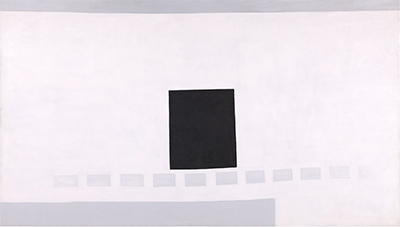The painting is dated at around 1952-1954, by which point she was truly established as an artist and feeling confident enough to approach new ideas without any restraint or anxiety. It is possible that influences from other artists may have started to impact her by this point, as she looked to move on from the genres of earlier in her career. Research has allowed us to uncover the meaning of My Last Door, with the setting actually being her home in Abiquiu. The piece is now owned by the exceptional Georgia O'Keeffe Museum which is located in Santa Fe, USA. It is 84 inches wide by 48 inches tall and this is consistent with how the artist was working on much larger canvases at this point in her career.
If we study the composition itself, we find the large black square placed fairly centrally, with two dark grey stripes across the top and bottom of the canvas. There is also a series of dashed lines just below the square. One immediately recognises the door mentioned in the title as being the black square, and we understand that the lines below are stepping stones which have been seen in photographs of the artist's home. The thicker lines have not been identified but are consistent with the style of decoration used on home exteriors in this part of the country. We are still unsure as to why she chose to go down such an abstract path for this venture, though, when other paintings created in and around her home were full of much greater levels of detail.
When one considers the abstract shapes found in My Last Door, there are many artists whose work bears similarities. The 20th century was full of self-expression and many approached art from the angle of abstraction. One who first springs to mind would have to be Kazimir Malevich, who took things about as far as they could go, once even created a painting which captured a white square on a white background. That was titled White on White, and there were also other relevant pieces such as Black Square, Black Circle and Black Cross. Indeed, the last of those bears a clear connection to O'Keeffe's own Black Cross, though with her version being superimposed upon her local landscape in New Mexico. Abstract art was truly international by this stage, with American artists influencing others for the first time, and also many from Russia having an equally significant impact on West European art as well.

